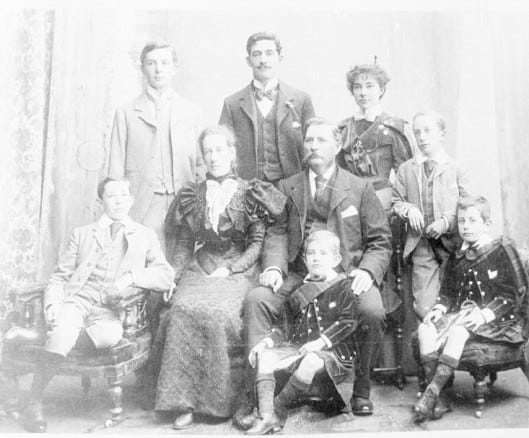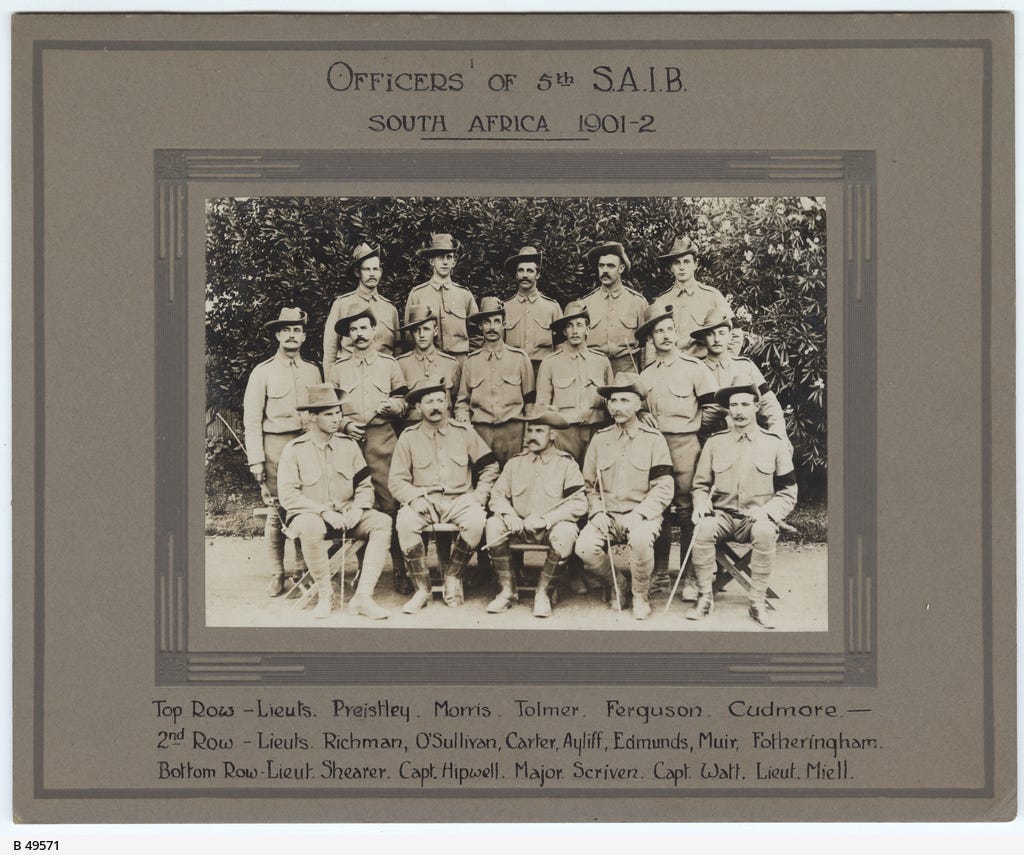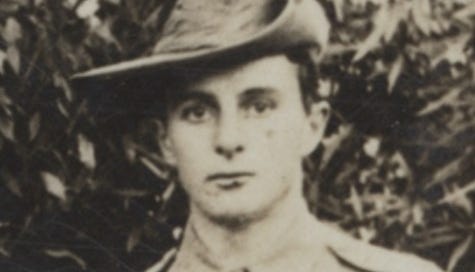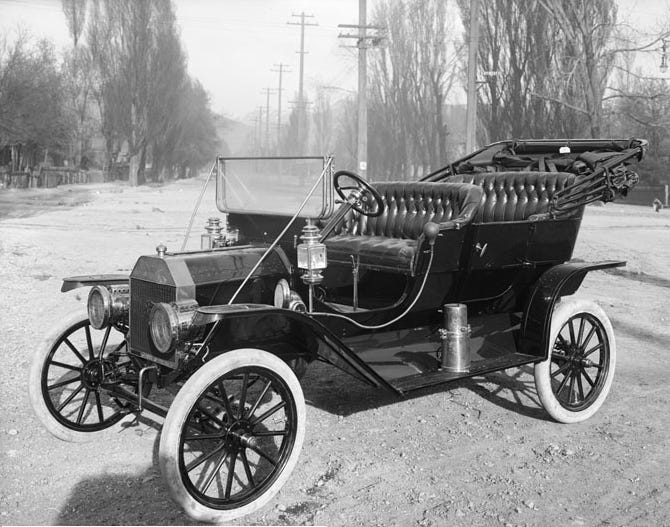Roland Herbert Cudmore (1879 – 1913) was my great grandfather’s first cousin; thus he is my first cousin three times removed. He served in the Second Boer War, and this he survived, but a decade later he was killed in a car crash.
Roland, the son of Daniel Henry Cashel Cudmore (1844 – 1913) and Harriet Garret Cudmore née Smedley (1844 – 1879), was born on 26 February 1879 at Avoca Station on the Darling River near Wentworth, New South Wales. His mother Harriet died on 16 March, less than three weeks afterwards.
Roland was the youngest of their five children. His siblings were:
Henry Carrington Cudmore (1872–1950)
Mary Avoca Cudmore (1874–1958)
Lillian Rosa Cudmore (1876–1877)
Milo Frank Cudmore (1877–1881)
In 1882 Roland’s father Daniel married again, to Martha Earle McCracken (1855-1938). They had four sons:
Daniel Wolseley Cudmore (1889–1903)
Paul Russell Thomas Cudmore (1883–1969)
Collier Robert Cudmore (1885–1971)
Milo Massey Cudmore (1888–1916)

Roland was educated at Hahndorf College.
Boer War
Roland Cudmore served in the Second Boer War as a Lieutenant in the Fifth South Australian Bushman Contingent, appointed in January 1901. He commanded “E” half-squadron.

On 9 February 1901 the Fifth South Australian contingent sailed for South Africa on the Ormazan. The contingent included of 23 officers, 310 men, and 346 horses. The voyage took six weeks.
The Fifth and Sixth South Australian units were brigaded with Imperial troops and placed under Colonel Beauvoir De Lisle.
On 6 June 1901 their first engagement was fought at Graspan, in present-day Siyancuma Local Municipality. An account of the Australian military contingents to the war in South Africa records the activities of the South Australians in that and subsequent engagements.
A composite force of 100 mounted infantry, and the same number of South Australians, made an early morning march and captured the whole of De Wet's convoy with six months' supplies. For four hours 160 men held out against the notable Boer leader and between 300 and 400 burghers, who attempted to re-capture it. ...
From the Harrismith district, trekked to Klerksdorp, and from thence to Bloemfontein. An attack was made upon General Smut's laager at Grootvallier. Lord Kitchener, in his despatch of the 8th August, stated that " Broadwood on the 29th July, made a night march on Bothaville, which resulted in his driving a number of Boers into the arms of Colonel De Lisle's South Australians, who captured 18 prisoners and 12 wagons. Major Shea, with 200 South Australians, made a gallant attack on Smut's commando at Grootvallier Farm, near the Vet River. Wire fencing, unseen in the darkness, prevented complete success of the plans, and enabled the Boers to escape, despite the fact that the South Australians pressed forward on foot, with fixed bayonets. Five Boers were left dead and 11 captured ... . By the 6th and 7th, Colonel De Lisle had accounted for 40 prisoners, 147 stand of arms, 600 horses, and 2,000 cattle." Three separate convoys were captured. Colonel De Lisle on 2nd August, congratulated the regiment on the successful night enterprises, and said that "the very dashing night attack at Grootvallier was worthy of the best traditions of Australian troops in the war."
After leaving Bloemfontein in August, trekked along the Basuto border, taking a number of prisoners, in addition to capturing the convoy of the Ficksburg commando. For the next two months they scoured the south-eastern portion of the Orange River Colony, then went north, where fighting and night marches were experienced. Then proceeded to Standerton, and from thence sent to relieve the late Colonel Benson's force after the Brakenlaagte disaster. The South Australians were the first to get to that place, after riding 75 miles in 22 hours. ...
The blockhouses were completed by February, and the Columns, abandoning the former system of operating individually, adopted the plan of moving together and driving the enemy on the railway or blockhouses.The Adelaide Observer of Saturday 28 September 1901 printed letters from soldiers, including one from Roland:
Lieut. R. H. Cudmore, of the fifth South Australian Imperial Bushmen, in a private letter, refers to the fight at Groote Vlei Farm as follows:—"Leaving camp at 11 p.m. D and F squadrons and 10 men of E squadron, in command of Mjr. Shea, marched 14 miles to the farm they were to attack, and just at daydawn they galloped the position. They had an exceptionally warm time of it, driving 40 or more Boers from their position in the farm. The enemy lost five killed and three wounded and 22 prisoners, our losses being two wounded. Capt. Watt and Lieut. McFarlane both had very narrow escapes (two of our best officers). The guns and pom-pom and one company sixth M.I., and remainder of E squadron left camp at 4 a.m. as reinforcements. After marching about five miles we were met by Capt. Legg, the intelligence officer, Cpl. Milne, and one of my men of E squadron. They reported the state of affairs with the attacking party. The whole of us then galloped the remaining eight miles, and arrived on the scene just in time to drive off a second commando of 200 Boers, who were surrounding our men, they having by this time taken cover in the farm houses and Kaffir kraals. On our arrival we sent along the voice of warning by the big guns speaking out with shrapnel. The enemy scattered, and were seen to retire in the direction of Gen. Owen's column, on our left. To-day we hear that Gen. Owen's column captured 80 wagons and 40 Boers flying in his direction. The enemy are all making south to Cape Colony, where Gen. French is giving them a warm reception. We leave here for Bloemfontein or thereabouts to-morrow at 2 a.m., and expect fighting all the way. Glen Railway Siding, near Bloemfontein, August 13.—We have just arrived here and pitched camp on the side of a high kopje, with Gen. Broadwood on our right. We came here for supplies, and expect to march in a northerly direction on the 15th inst. Lieut. Bert. Tolmer is still in Harrismith Hospital with a sore eye, but expects to return to us soon."In April 1902 members of the Fifth and Sixth South Australian Contingents returned to Australia on the transport Manchester Merchant. While in South Africa the contingents trekked 3,825 miles. The men had not been three consecutive days in one place. Thirteen men of the Fifth contingent died: five were killed in action, one drowned, the other seven died of fever.
Roland was awarded the Queen’s South Africa Medal with four clasps. He was one of seventeen Hahndorf College old boys whose war service was commemorated on a college tablet.
Marriage and children
Roland married Annie Isabella Porter on 26 September 1907 in Gilberton, South Australia. They had three children:
Daniel Murray Cudmore (1908–1948)
Colleen Mary Cudmore (1912–2006)
Margaret Earle Cudmore (1913–2004)
Car accident
Onn 22 October 1913 Roland was killed in a car crash on the road between Renmark and Mildura near Neds Corner, Victoria. He was driving a new Ford car which he had purchased shortly before the accident. On 24 October an inquest held at Mildura found his death, probably instantaneous, was caused by his car’s turning over. He was buried in Wentworth Cemetery with his mother.
Advertiser (Adelaide), 25 October 1913, p 19
FATAL MOTOR ACCIDENT.
MR. ROLAND CUDMORE KILLED.
A telegram was received in Adelaide on Thursday night conveying the sad tidings that Mr Roland Cudmore of Mildura had been killed in a motor accident. Mr Cudmore, who had been on a visit to his father (Mr. Daniel Cudmore), of Victor Harbor, left Adelaide on the return journey home at about 10 o'clock on Tuesday morning in a motor he had purchased about six months previously. Doubts were expressed at the time of the wisdom of his setting out on the long journey by himself, but he was confident that he would complete it safely, and started in the best of spirits. The car was found overturned at Ned's Corner late on Thursday afternoon, with Mr. Cudmore's crushed body lying beneath it.
Mr. Wilkinson, of Murthoo Station, was the first to know of the accident, and he hastened to Ned's Corner woolshed in his car and telephoned the news back to the station. Assistance was immediately sent to the scene, and telegrams were also despatched to Mildura, and a doctor, and the police were advised. Mr. Arthur Crozier, of Kulnine Station, rendered help, and after releasing the body he conveyed it in his car to Mildura.
It is estimated that Mr. Cudmore would reach Ned's Corner by about 12 o'clock on Wednesday and he must, therefore, have been lying under the car for a day before he was discovered. He left a widow (a daughter of Mr. J. W. Porter) and three children, the eldest of whom is only about 3 years of age. Mr Cudmore was educated at St Peter’s College, and served in the South African War as an officer of the first contingent, gaining the Queen’s Medal and four clasps for service in action in Cape Colony and Orange River Colony. He was very well known in Adelaide, and possessed a wide circle of friends.
It is about eight years since he took up land at Mildura.
Mr. H. Cudmore, of New Zealand, is a brother and Mrs. Milroy Smith, of Tasmania, a sister. Mrs. Cudmore is a sister of Mrs. C. L. Jersop, Mrs. W. A. Verco, Mrs. V. M. Newland (British East Africa), Mrs W. Angus, and Mr. F. W. Porter.
Renmark, October 24
Mr. James Wilkinson, of Murtho Park, was returning with his wife from the Darling River on Thursday, when he found the overturned car about eight miles below the Kulnine station homestead. Mr. Cudmore's arm and head were pinned below the left side of the car. Mr. Cudmore had apparently been dead many hours. From appearances, the car turned suddenly in its tracks, owing to the slippery nature of the ground. Mr. Wilkinson came on to the Ned's Corner woolshed and telephoned the news to the Mildura police and to Mr. Arthur Crozier of Kulnine.
Mildura Cultivator (Vic.), Saturday 25 October 1913, page 6
MR. ROLAND H. CUDMORE KILLED. A gloom was cast over the town and settlement on Thurs-day by the news that popular Roland Cudmore had been killed while motoring up from Adelaide via Renmark. It ap-peared that Mr. Cudmore journeyed by motor to Adelaide a few days ago to visit his father who was ill. He was expected back in Mildura on Thursday and a telegram was received from Morgan on Wednesday, fixing an hour for his arrival. He was seen to pass the Ned's Corner wool-shed, but was not heard of afterwards until a motorist named Wilkinson telephoned to Ned's Corner from Murtho to say that he had passed an overturned motor car, with a man lying underneath. Mr. Arthur Crozier went with his motor expert, Mr. Alan Lyell Hodgson, and book-keeper (Mr. Basil Chambers Herbert) to the spot indicated. On the Renmark road, about 44 miles from Mildura, seven miles from Kulnine and two miles from Ned's Corner Homestead, they found an overturned Ford motor car and Mr. Cudmore's body underneath. It was then 8.30 o'clock in the evening. Examining the track over which the car had travelled, it was found that it had passed through a wet and slippery "soak " on the middle of the road and had been turned aside to miss further slush ahead. This movement apparently caused the car to side-skid for a distance of 20 yards when it hit the hard ground the car over-turned sideways and pinned the driver down. A mistake that apparently been made in trying to swerve in the soft ground while going at a good rate of speed. The brake may have been applied, which would have caused a capsize with the motor at the top gear. The accident occurred in clear, open country, well-known to deceased. The glass screen of the car was broken and one wheel appeared to be out of alignment, the axle being bent, but beyond a general scattering of tools no further damage was apparent. The car was left there for inspection by the police. Deceased's pipe and false teeth were found near his body which was very discolored; having apparently been lying for some time on the road. The weight of the car was resting on the small of the back of deceased, whose feet were entangled in the wind-screen supports. There were no signs of a struggle. The overturned car was pointing towards Renmark. Showers of rain fell on the locality on Wednesday. Deceased was seen to pass Ned's Corner woolshed at 9.10a.m on Wed-nesday, 36 hours before the body was found. Mr Crozier's first notification of an accident was an enquiry from Avoca Station. The body was brought from Kulnine to Mildura by motor car and placed in the Morgue 2 a.m. yesterday.
According to Mr W. A. Yule, deceased was a good driver and not nervous or timid. Sergeant Carter also knew him as a careful and competent driver, who had driven his father's car frequently before he got a car of his own.
A coronial enquiry was conducted yesterday morning by Mr James Matthew, J.P., and a jury of twelve, comprising Messrs J. W. Green (foreman); J. M'Coll, J. Egan, S. Ford, G. Harston, J. Buxton, G. A. Nash, A. Shear, E. C. Pugsley, A. Sharp, F. Brown and J. W. Washington. Mr. Matthew explained that only the previous day he had received instructions that, in the event of a death by motor car or motor bicycle accident a jury must be empanelled. After hearing the evidence the jurors desired an adjournment to allow of the attendance of the man Wilkinson, who appears to have seen the body much earlier than Mr. Crozier and his assistants. An adjournment to Friday the 7th November, was ordered.
Mr Cudmore had been associated with this district for practically the whole of his life, having been born at Avoca Station. Some years back he figured as a bicycle rider of considerable promise and later he went to the Boer war as a member of a South Australian corps of infantry- and became a lieutenant. After his return to Australia he married and settled in Mildura, where he was widely popular and a prominent figure in social circles. He was captain of the Golf Club, a cricketer and a member of the South African Returned Soldiers' Association. Sympathy with the family is widespread and sincere. There are three children - the youngest being less than three months old. Mr. Cudmore's age was 34.
The funeral will leave the residence of Dr. Cameron at 11 o'clock this (Saturday morning) and the body will be interred in Wentworth Cemetery.
Mildura Cultivator (Vic.), Wednesday 5 November 1913, page 5
MEMORIAL SERVICE AT ST. MARGARET'S.
LATE LIEUT. ROLAND CUDMORE.
The military church parade to attend the memorial service to the late Lieutenant Roland Cudmore —boy-veteran of the SouthAfrican war—at St Margaret's on Sunday morning, drew forth 17 members of the South African Soldiers' Association, 26 members of the Legion of Frontiersmen and some 50 cadets. The whole body, the veterans, wearing their medals, leading, formed up at the residence of Major Brown and marched to church under the courtesy-command of Lieutenant H. Williams, adjutant of the 73rd Infantry, who is on visit to Mildura as an officer of the regular forces. The Rev. R. B. Davison, the vicar, preached a most impressive, short, but comprehensive sermon fitted to the occasion. Taking as his text the latter part of the 22nd verse of the 15th chapter of Paul's epistle to the Corinthians: "Even so in Christ shall all be made alive," the vicar first drew attention to the sterling qualities of the man so swiftly and tragically taken away from us. Roland Cudmore was not only a good husband, father and ordinary citizen, but a man who had been ready to do his share in defending home and country; the man not ready to do that had no conception of the sacredness of manhood. Those who possessed such fine attributes are still existent, although removed to higher state. Life, said the vicar, impressively, touching upon the immortality of the soul, is not bounded by a few years on earth. The so-called dead and the living are all members of one body—the body of Christ. The good works of men are treasured and laid up in Heaven, the grave does not separate living and dead, but someday and somewhere we shall be re-united. The death of a friend must not come as a calamity, but as a message from God, made beautiful and sweet by the promise of the life hereafter. Those friends present and those bereaved nearer ones, must think of Roland Cudmore as still being in their midst—a spirit presence. Very impressive, indeed, grew the vicar as he spoke earnestly on the Resurrection and the Life, and few but would go away not feeling helped by the little sermon. The hymns for the service also lent themselves to its impressive-ness, the simple words of "Lead Kindly Light" and another hymn, dealing with the resurrection from death to life, hitting home to even the hardest old soldier present. And so the soldiers paid very last honors to their young comrade. It is good to think that no clean, brave man dies utterly; that sometimes when his memory is with us his spirit may be hovering near, smiling return to our bitter-sweet recollection of something he said or did in life on earth. Therefore, though it is vale atque vale in ordinary thinking, let us hopefully await our comrade's kindly ave when we, too, pass into the great Beyond.Related posts and further reading
Posts concerning Roland’s father: Daniel Henry Cashel (1844–1913): Trove Tuesday: 1905 Bushfire precautions , The tristate tour February 2021 part 1 , and A is for Avoca
Posts concerning Roland’s half-brothers:
Collier Robert Cudmore 1885–1971 : C is for Collier
Milo Massey Cudmore 1888–1916 : S is for St Eloi
Boer War:
Official records of the Australian military contingents to the war in South Africa compiled and edited for the Department of Defence by P.L. Murray. 1911. Fifth and Sixth (Imperial) Contingents pp. 364-376 https://www.awm.gov.au/collection/C1416438
OUR SOLDIERS. THE FIFTH AND SIXTH CONTINGENTS. A RETROSPECT. (1902, April 14). The Advertiser (Adelaide, SA), p. 5. Retrieved from http://nla.gov.au/nla.news-article4883350
THE GRASPAN FIGHT. (1901, July 30). The Advertiser, p. 9. Retrieved from http://nla.gov.au/nla.news-article4849524
THE TRANSVAAL CAMPAIGN. (1901, September 4). Evening Journal (Adelaide, SA : 1869 – 1912), p. 3 (ONE O’CLOCK EDITION). Retrieved June 14, 2025, from http://nla.gov.au/nla.news-article207955518
TREASURE TROVE. (1901, September 28). The Advertiser (Adelaide, SA : 1889 – 1931), p. 8. Retrieved June 14, 2025, from http://nla.gov.au/nla.news-article4858186
SOLDIERS LETTERS. (1901, September 28). Adelaide Observer (SA : 1843 – 1904), p. 15. Retrieved June 14, 2025, from http://nla.gov.au/nla.news-article161764296
This post first published at https://anneyoungau.wordpress.com/2025/06/14/roland-herbert-cudmore-1879-1913/




This is tragic Anne. I can imagine how happy his family must have been to have him home from the war. For an accident to take his life on his return is so sad.